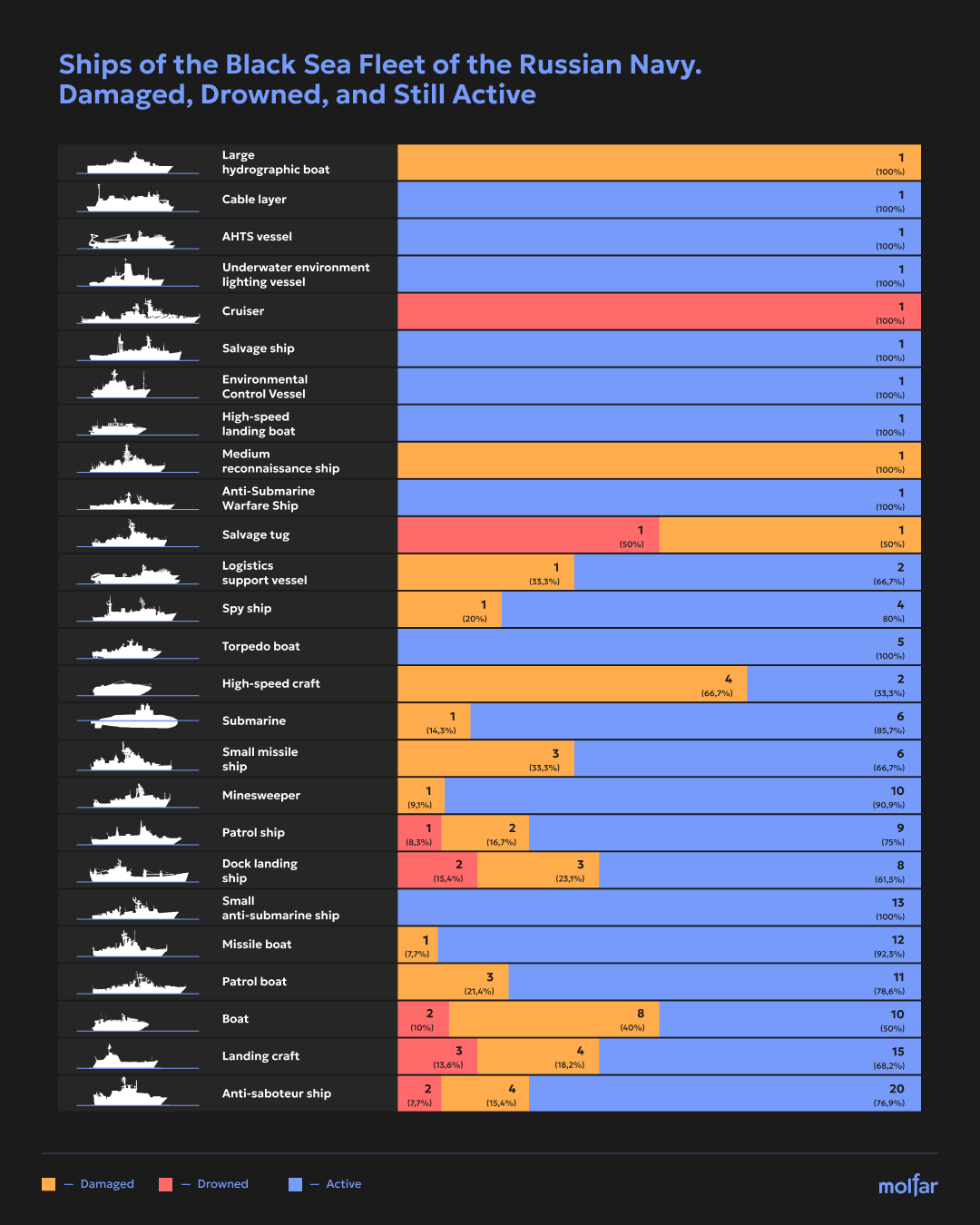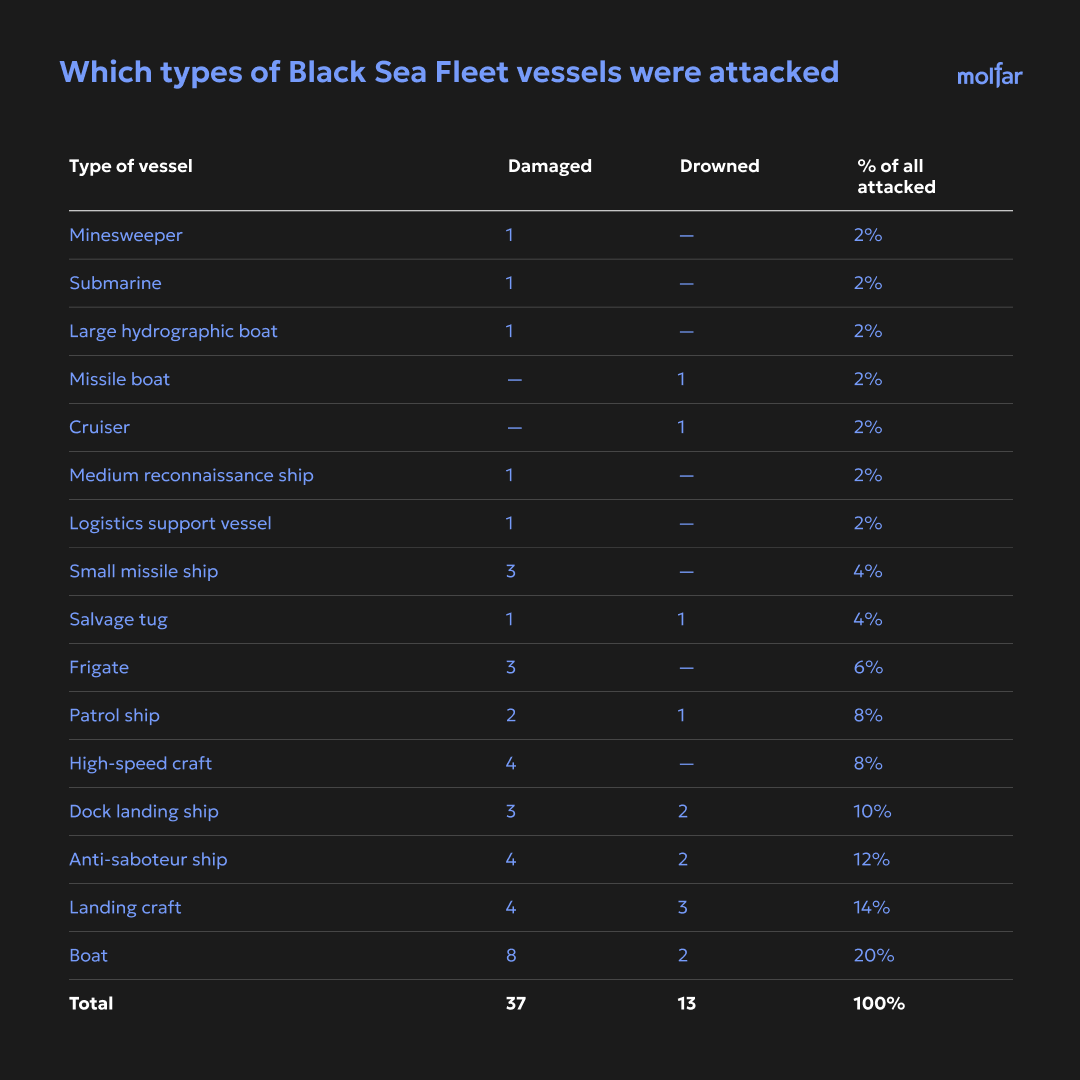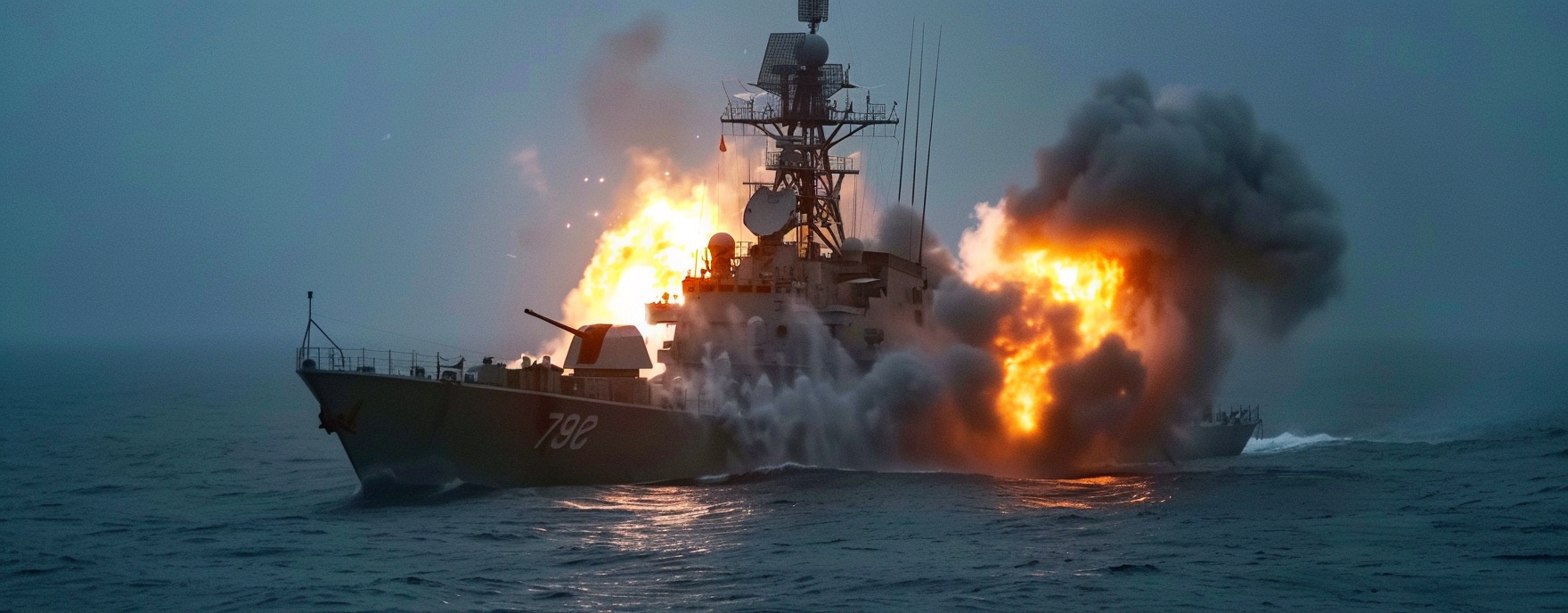05/03/2024
Landing ships, the fleet's flagship, corvettes, boats, and even submarines—this list of the types of ships Russia has lost since the full-scale invasion of Ukraine began is far from complete. In this article, Molfar analyzes the vessels lost by Russia.
Which Ships of the Russian Fleet Have Already Been Destroyed

Patrol Ship “Sergey Kotov”
On March 5, 2024, the Russian ship "Sergey Kotov" had sunk, reportedly carrying a Ka-29 helicopter onboard. Defence Intelligence of the Ministry of Defence of Ukraine (Ukrainian — ГУР МО [GUR MO]) described the successful operation to destroy the Russian vessel.
Subsequently, GUR MO released a video on their official social media, confirming the ship's destruction. Intercepted communications from the occupants revealed that "Sergey Kotov" was attacked by five uncrewed boats during the strike — "Magura V5" drones. The Russian ship suffered damage to its stern, right, and left sides.
The "Sergey Kotov" is a patrol ship of the "Project 22160" class. It's designed for patrolling, monitoring, and protection purposes. The Russians have launched four of these ships, with two more under construction. All of them are based in the Black Sea. “Vasily Bykov”, “Pavel Derzhavin”, and “Sergey Kotov” have already been attacked by Ukrainian defenders. Only “Dmitry Rogachev” remains undamaged.Yet.
These ships typically have a helicopter deck and a hangar for one Ka-27 or Ka-226 helicopter. Their armament includes "Kalibr-NK" missiles (which come in several versions, including anti-ship, land-attack, and submarine-launched, with a range of up to 2500 kilometers), a 76.2 mm dual-purpose artillery mount, and other defense systems.
In Russia, "Project 22160" is one of the most modern projects. However, Russians have criticized the ship, claiming it has weak armor and insufficient defense. Overall, the ships do not meet their claimed specifications.
Small missile ship "Askold"
The corvette "Askold" from the 22800 "Karakurt" project hadn't even left the shipyard when Ukrainian missiles hit it on November 4, 2023. "Askold" reportedly remained afloat, but due to significant damage to its critical components, it needs to be built "from scratch" again.
The "Karakurt" class represents a series of small and multipurpose Russian ships armed with missiles and artillery. These vessels can perform various tasks, from patrolling waters to engaging enemy ships and supporting amphibious operations. The "Karakurts" are equipped with modern missile systems, including the same "Kalibr-NK" missiles, making them a significant element of the Russian navy.
Destruction of the ship "Caesar Kunikov"
The Russian Black Sea Fleet's large landing ship "Caesar Kunikov" was destroyed on February 14, 2024. The strike also employed "Magura V5" sea drones. The attack was carried out by the special forces of "Group 13" of the Ukrainian GUR MO near Alupka in the temporarily occupied Crimea. The ship was hit by critical breaches on its port side and began to sink. The Russian rescue operation was unsuccessful. As a result of the attack, the majority of the crew, which numbered 87 people, perished.
The “Caesar Kunikov” is one of the large landing ships of the "Project 775" series, codenames the “Ropucha” class by NATO. It had a displacement of 4,080 tons and could carry up to 500 tons of equipment and cargo, along with 225 marines. Its armament included:
- Two 57 mm artillery mounts AK-725.
- Launchers for the Grad-M multiple rocket launch system.
- Forty-four launchers for the Strela-2 man-portable air-defense system (MANPADS).
How "Moskva" sank
The sinking of the Russian cruiser "Moskva" became one of the most significant events in Ukraine's defense against Russian aggression. This was achieved thanks to the accurate use of Ukrainian "Neptune" missiles. For the Russians, it was a surprise and a serious blow, both figuratively and literally.
The cruiser "Moskva" was the flagship of the Russian Black Sea Fleet and played a key role in the Russian naval forces. Therefore, the sinking of this vessel is considered a strike against Russia's military capabilities, especially in the Black Sea region.
The "Moskva" was a large missile cruiser of the Project 1164 "Atlant" class, armed with missile weapons, anti-aircraft missile systems, and artillery. This ship also played a role in southern Russia's defense capability. The sinking of the "Moskva" demonstrated the vulnerability of even the most protected elements of the Russian fleet to Ukrainian missile weaponry.
One of the surviving sailors of the cruiser mentioned in a private conversation with his mother that the ship was heading towards Odessa. They were planning an amphibious operation intended to capture the city.
General analysis of the losses of the Russian fleet
An analysis of the Russian fleet's losses shows that strikes were delivered across a broad spectrum of naval forces. Both small and large ships performing various functions, from amphibious operations to patrolling, were destroyed.
The most vulnerable turned out to be patrol boats and landing craft, indicating the high effectiveness of Ukrainian defense means. The losses of large landing ships and frigates diminish the aggressor's capability to conduct large-scale maritime operations, having long-term strategic consequences for the Russian fleet.

The total number of Russian ships destroyed is 13 units, with landing craft forming the most significant portion at 25%. Approximately 16% of the sunken vessels are large landing ships, critically important for the aggressor's naval forces. These ships are responsible for delivering significant troops, equipment, and materials directly to the shore.
_1709743945.png)
Research Methodology
The Molfar analytics team collected data on the Russian fleet in several stages: from a Russian website about the Black Sea Fleet, using data on damages and sinkings of ships found on various news sites and Telegram channels, and reviewing video recordings from the scenes. During the analysis, ships that were under repair or part of the fleet's logistical support were not considered.
This approach gave a comprehensive picture of the Russian fleet's losses in the Black Sea from the full-scale invasion on February 24, 2022, to February 15, 2024.
184 Russian Black Sea Fleet military vessels were identified, including six large landing ships and at least one anti-diver sapper boat. Fifty-one units were struck, accounting for approximately 21% of the total number. Of these, 12 ships were sunk entirely, making up 23.5% of all hits. Among the struck vessels, various boats were particularly affected — 19 units, with eight sunk.
The occupation of Crimea in 2014 was a turning point when Russia significantly increased its military presence in the region, including aviation, coastal missile systems, air defense means, and, of course, ships. The Russians commissioned 3 "Admiral" series frigates, 4 "Buyan-M" project small missile ships, several "Vasily Bykov" type patrol ships, and six submarines.
We will continue to monitor developments with the Russian fleet in the Black Sea.




